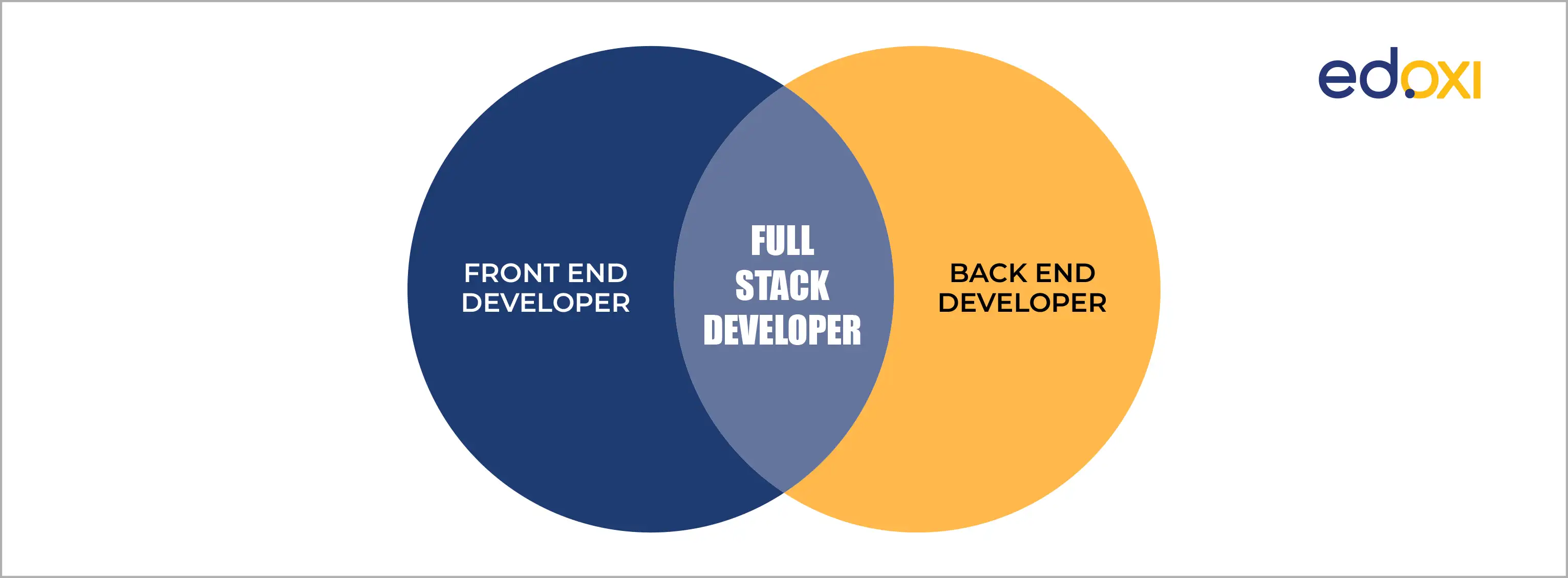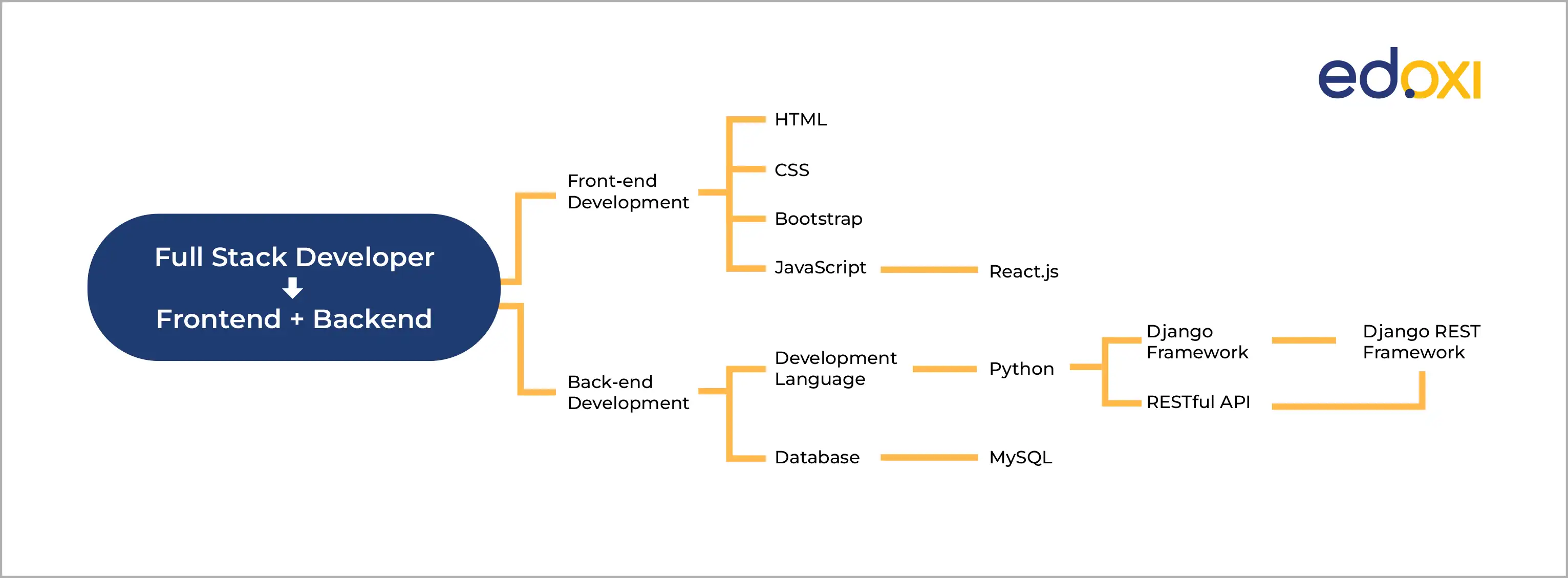Overview of Full Stack Developer Training in Bangalore
A recent report indicates a 30% increase in demand for Full Stack developers in India. Edoxi’s Full Stack Developer Course in Bangalore aims to offer you intensive training to excel in today’s competitive world. Our training covers front-end development basics like HTML, CSS, and the React.js JavaScript framework.

Edoxi’s Full Stack Development course is tailored for individuals and professionals from IT and non-IT backgrounds. You can choose Python over Node.js and relational (MySQL) over MongoDB (NoSQL) accordingly. You will also get the opportunity to work on projects on website building where you will implement various functions such as User Interface (UI) Development, Search Functionality, Interactive Design, Data Management, API Development, Payment Integration, Data Fetching, and Display.
Benefits of Full Stack Developer Training
- Get high-paying jobs: Full Stack developers are always in demand from startups to enterprises. There are a lot of high-paying jobs across the globe. Our training will also enable you to work as a freelancer.
- Learn from the basic level: Regardless of your IT background and skills, you will become proficient in Full Stack development through projects and case studies that will give you better clarity on databases and other crucial topics.
- Acquire the latest web development skills: This course will help you master modern web development components such as MongoDB database and Node.js programming language, known for its high adaptability, high performance and developer friendliness.
- Enhance your level of competency: Participants can learn Node.js as a back-end development language instead of Python and React.js as a front-end development language that will enhance efficiency and productivity in web development.
- Boost your portfolio: As a part of our training, you will get the opportunity to work on dynamic website development projects that will strengthen your portfolio.
Features of Full Stack Developer Training
-
Start from beginner’s level:
This course suits individuals from both IT and non-IT backgrounds. If you have zero web development, you can start from the beginning.
-
Project-oriented class:
You will work on an extensive web development project during the course. The project will start on the third day of the course.
-
Flexible timing options:
You have weekdays and weekend options and it can be completed within 2 or 3 months. You have the freedom to finish your project at your own pace.
-
Course customisation:
We will customise the course according to your requirements. You have the customisation option in both back-end and front-end development training.
-
60-hour extensive course:
The 60-hour extensive course will touch every aspect of front end, back end and database to prepare you to become a Full Stack developer.
-
Online and Classroom Sessions:
You can choose either online or classroom sessions for our Full Stack developer course.
Industries Looking for Full Stack Developers
Technology and Software Development Companies
Retail
Finance and Fintech
Healthcare Sector
E-commerce
Education Sector
Media and Entertainment
Travel and Hospitality
Government Organisations
Prerequisites For Full Stack Development Course
- Anyone from a technical or non-technical background who wants to start a career in Full Stack Development regardless of their degree or experience can join this course.
Full Stack Course Modules
- Module 1: Introduction to HTML, CSS, and Javascript
- Session 1: Introduction to Web Development
- 1.1 Overview of Web Development
- Understanding the roles of HTML, CSS, and JavaScript
- Overview of front-end and back-end development
- 1.2 Setting Up a Development Environment
- Choosing a code editor (e.g., Visual Studio Code)
- Introduction to browser developer tools
- Session 2: HTML Fundamentals
- 2.1 Introduction to HTML
- Structure of an HTML document
- HTML tags, elements, and attributes
- Semantic HTML for better structure
- 2.2 Creating a Basic Web Page
- Building a simple webpage with HTML
- Working with headings, paragraphs, lists, and links
- Session 3: CSS Fundamentals
- 3.1 Introduction to CSS
- Understanding the role of CSS in styling web pages
- CSS syntax and selectors
- 3.2 Styling Web Pages with CSS
- Adding styles to HTML elements
- Working with colours, fonts, and backgrounds
- Session 4: Layout and Box Model
- 4.1 Box Model in CSS
- Understanding the box model (margin, padding, border)
- Controlling dimensions and spacing
- 4.2 Page Layout Techniques
- Introduction to layout techniques (flexbox, grid)
- Creating responsive layouts
- Session 5: JavaScript Basics
- 5.1 Introduction to JavaScript
- Role of JavaScript in web development
- Basic syntax and data type
- 5.2 Working with Variables and Operators
- Declaring variables
- Mathematical and logical operators
- Working with arrays and objects
- Session 6: Control Flow and Functions
- 6.1 Conditional Statements
- if, else if, else statements
- Switch statements
- 6.2 Functions in JavaScript
- Defining functions
- Parameters and return statements
- Session 7: DOM Manipulation
- 7.1 Introduction to the DOM (Document Object Model)
- Understanding the DOM structure
- Accessing and manipulating DOM elements with JavaScript
- 7.2 Event Handling
- Handling user interactions with events
- Common events (click, submit, etc.)
- Module 2: MONGO DB
- Session 1: Introduction to MongoDB
- What is MongoDB?
- NoSQL vs. SQL databases
- Key features of MongoDB
- Installation and Setup
- Installing MongoDB
- Exploring MongoDB shell
- Data Modeling in MongoDB
- Session 2: Introduction to MongoDB
- BSON data format
- Collections and documents
- Schema design considerations
- CRUD Operations
- Creating, reading, updating, and deleting documents
- Using the MongoDB shell for CRUD operations
- Session 3: Querying and Data Retrieval
- Querying with MongoDB
- Basic queries
- Comparison operators
- Logical operators
- Array queries
- Indexing and Performance Optimization
- Importance of indexing
- Creating and managing indexes
- Query performance optimisation
- Aggregation Framework
- Session 4: Introduction to the aggregation pipeline
- Aggregation stages: $match, $group, $project, etc.
- Examples of complex queries
- Geospatial Data in MongoDB
- Storing and querying geospatial data
- Geospatial indexing
- Real-world applications
- Module 3: Angular Course Outline
- Session 1: Introduction to Angular
- What is Angular?
- Key features and benefits
- Angular versions (AngularJS vs. Angular)
- Setting up the Development Environment
- Installing Node.js and npm
- Angular CLI (Command Line Interface)
- Creating your first Angular application
- TypeScript Fundamentals
- Session 2: Introduction to TypeScript
- TypeScript features (static typing, interfaces, classes)
- Using TypeScript with Angular
- Angular Modules and Components
- Creating and organising modules
- Creating and using components
- Component lifecycle hooks
- Session 3: Building Angular Applications
- Data Binding
- Property binding
- Event binding
- Two-way data binding
- Directives and Structural Directives
- Session 4: Introduction to directives
- Built-in directives (ngIf, ngFor)
- Custom directives
- Services and Dependency Injection
- Creating and using services
- Dependency injection in Angular
- Singleton services
- Routing and Navigation
- Session 5: Setting up Angular Router
- Configuring routes
- Navigating between components
- Forms and Form Validation
- Template-driven forms
- Reactive forms
- Form validation and error handling
- Session 6: Building Real-world Applications
- Creating a CRUD Application
- Building a simple CRUD application
- Module 4: React.js course outline
- Session 1: Introduction to React.js
- 1.1 Overview of React.js
- What is React?
- React.js component-based architecture
- Virtual DOM and its benefits
- 1.2 Setting Up a React Development Environment
- Installing Node.js and npm
- Creating a new React application using Create React App
- Understanding the project structure
- Session 2: JSX and Components
- 2.1 Introduction to JSX
- Syntax and features
- JSX vs. HTML
- 2.2 React Components
- Creating functional components
- Class components and their lifecycle methods
- Props and state in React components
- Session 3: State and Props
- 3.1 Managing Component State
- Understanding state in React
- setState method and asynchronous updates
- Handling user input and forms
- 3.2 Working with Props
- Passing data between components using props
- PropTypes for prop validation
- Default props
- Session 4: React Hooks
- 4.1 Introduction to Hooks
- useState for managing state in functional components
- useEffect for side effects in functional components
- Rules of Hooks
- 4.2 Additional Hooks
- useContext, useReducer, and other custom hooks
- Best practices for using hooks
- Session 5: React Router
- 5.1 Introduction to React Router
- Setting up routes in a React application
- Route parameters and navigation
- Nested routes and route guards
- 5.2 Navigation Patterns
- Redirects and conditional rendering
- Using NavLink and withRouter
- Module 5: Node.js Course outline
- Session 1: Introduction to Node.js
- Overview of Node.js
- Installation of Node.js and npm
- Setting up a basic Node.js application
- Understanding the event-driven, non-blocking architecture of Node.js
- Session 2: JavaScript ES6+ for Node.js
- Refreshing core JavaScript concepts
- Introduction to ES6 features (let and const, arrow functions, template literals)
- Exploring Promises and Async/Await for asynchronous programming
- Session 3: Node.js Basics
- Introduction to CommonJS modules
- Creating and importing modules
- Working with npm packages and package.json
- Understanding the event loop and asynchronous programming in Node.js
- Session 4: Building Web Servers with Express.js
- Introduction to Express.js
- Setting up an Express.js application
- Handling routes and requests
- Implementing middleware in Express.js
- Session 5: RESTful API Development
- Designing RESTful APIs
- Handling HTTP methods (GET, POST, PUT, DELETE)
- Implementing routing with Express.js
- Using the Express.js Router for modular routing
- Session 6: Database Integration
- Connecting to databases (MongoDB, MySQL, etc.)
- Performing CRUD operations with Node.js
- Introduction to Mongoose (for MongoDB)
- Defining schemas and models with Mongoose
- Session 7: Authentication and Authorization
- Implementing user authentication with Passport.js
- Token-based authentication for Securing APIs
- Role-based access control for authorisation
- Securing routes and resources in an Express.js application
- Session 8: Real-time Communication with WebSocket
- Understanding WebSocket protocol
- Setting up WebSocket in Node.js with Socket.io
- Building a real-time chat application
- Version Control and Continuous Integration (10 hours)
- Git basics
- GitHub/GitLab usage
- CI/CD Pipeline
- Content cluster
- Transactional intent
- Directional intent
- React JavaScript
Full Stack Development Projects
As a part of the Full Stack Development Project, participants can design user interfaces, data visualisations, and interaction flows based on their creativity. You have the choice to develop your own website, be it your portfolio website, your business website, or the kind of website that is required to build in the industry you are looking to enhance your career. Participants have the flexibility to finish the project within their timeframe.
If you do not have a predefined requirement, our expert trainers will guide you to develop a full-fledged yacht booking website based on the front-end and back-end lessons you learn from the course. Simultaneously you will work on the project to gain hands-on experience. This project will allow you to experiment with your skills in front-end development (HTML, CSS, React.js) and introduce you to back-end development concepts with Node.js and MongoDB. The process of the project is as follows:
Front-End
- Plan a unique website layout and interface using your creativity. (If not, you can use the pre-defined user interface developed by the trainer.)
- Set up a development environment: How to install software that is required to develop the website. Visual Studio Code for HTML, CSS and JavaScript, Node JS for React, and Angular CLI for Angular.
- You will learn to create divs, sections, and other elements using HTML. On the website, you will develop multiple sections such as the hero section, availability calendar, booking process, features, offers, contact us, testimonials and so on.
- You will experiment with how to add an image, how to create different styles and sizes of fonts, how to create a form (through which you read the input from the user), how to add a logo, how to create buttons, how to load images dynamically, adding YouTube link and opening it as a new page.
Back-End Development
- Create a basic Node.js server to handle data requests from the front end: This process allows the server to receive the response from a user and provide results to the front end for the query from a user.
- Work on MongoDB database: Set up a local MongoDB instance (or use a cloud-based option) to store mock yacht data (name, description, image, etc.)
- API Integration: Develop basic Node.js API endpoints to simulate fetching yacht data from the database. These endpoints would be called by your React components to populate the website with yacht information.
- At the end, you will do the testing and deployment of the website.

How to Get a Fullstack Developer Certification?

Locations Where Edoxi Offers Full Stack Development Course
Review & Ratings



FAQs
You can pursue the following job roles after the completion of this course,
- Full stack Engineer
- Full stack Developer
- Web Developer
- App Developer
- Software Developer
- DevOps Engineer
The following are the objectives of full-stack developer training,
- Understanding how to build complex web applications.
- Develop skills in various Programming languages.
- Gain a full spectrum of knowledge on Web Development.
- To impart confidence to lead challenging IT projects
The following are the essential soft skills required for a Full Stack Developer,
- Time management skills
- Problem-solving skills
- Critical thinking
- Communication skills
Upon the successful completion of the Full Stack Developer Course at Edoxi, you will acquire skills in,
- Front-end languages and frameworks.
- JavaScript programming language.
- Backend technologies and frameworks.
- Database management skills.
- Skills to understand client requirements.
- Analytical thinking and problem-solving.
The average salary of a Full Stack Developer is ₹8,58,000 per year in Bangalore.
The students can choose either Angularjs or Reactjs for the front-end development.
Full Stack Developer Training in Bangalore equips individuals with the skills needed to create robust tech products. Participants will get multiple study aids and we provide flexible class timings. Our upgraded Full Stack Course curriculum and industry-led instructors will accelerate your career in Full Stack development. Enrol now and accelerate your career growth!




